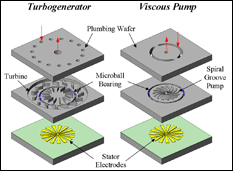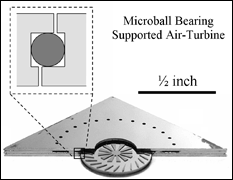Clark School Researchers Are First to Manufacture and Integrate |
|
FOR IMMEDIATE RELEASE CONTACT: Christopher M. Waits (Army Research Laboratory) Every fatigue-inducing pound matters, including the 20 pounds of lithium ion and other batteries that power those digital devices.
The engineers' advances also hold promise in technologies for health care (micropumps for implantable medical devices) and first responders (bio-chemical sensors). "For the first time, we have achieved a level of miniaturization for machines like that achieved over the last decades in electronics," said Ghodssi, Herbert Rabin Distinguished Associate Professor of Engineering in the Clark School's Department of Electrical and Computer Engineering and Institute for Systems Research, and director of the MEMS Sensors and Actuators Laboratory. "Our work shows that it is feasible to manufacture and integrate reliable, robust micromachines that apply tiny pumps, motors, and turbines in ways never before possible." Using well-known manufacturing techniques similar to those used in the semiconductor industry to make computer chips, the Clark School researchers have successfully miniaturized ball bearing support mechanisms with microballs as wide as a few human hairs and nearly invisible to the naked eye. Using these components, they have built tiny silicon pumps, motors, and turbines demonstrating rotational speeds of up to 87,000 rpm, comparable to the speed of large-scale machinery. "Early MEMS devices used sliding and air bearings," explains Jeffrey H. Lang, professor of electrical engineering at MIT. "The Clark School team has now added ball bearings to the micro-scale world, which gives the designers of MEMS devices a very exciting and significantly different bearing option. These bearings should enable the development of MEMS devices that would not be practical with other types of bearings." "Traditional actuators built for micro systems are restrained to linear motion or small-angle rotation," adds Rajinder P. Khosla, program director in the Division of Electrical, Communications, and Cyber Systems of the National Science Foundation's Directorate for Engineering. "In Dr. Ghodssi's lab, microball bearings have been implemented in electrically-actuated rotary platforms for controlled angular positioning as well as high-speed turbomachinery for microscale fuel pumps. The successful development of these devices will lead directly to the realization of small-scale power generators and high-performance directional sensors systems." For troops on the battlefield, small-scale combustion generators using such micromachines, and combined with batteries in hybrid technologies, will significantly reduce the soldier’s load. States Bruce Geil, acting branch chief for the Power Components Branch of the U.S. Army Research Laboratory, "The Army needs small-scale, liquid-fueled power generators that can provide higher energy, at lighter weight and lower cost, than current fielded power sources. Ghodssi's team is developing key fuel delivery and electrical generator components to meet our requirements." Micromachine systems also will help power land or air-based "micro vehicles" (also under development at the Clark School in partnership with government agencies) that will venture into risk-filled environments ahead of soldiers or first responders and send back information. Microgenerators fabricated completely in silicon and supported on microball bearings could power the vehicles’ electrical systems without weighing them down. More broadly, micromachine systems will be vital resources for corporations that seek to offer new products to their existing markets or to create entirely new markets. Notes Carl B. Friedhoff, technical fellow, Northrop Grumman Corporation, "Dr. Ghodssi's work adds an important new approach to producing mechanical movement in MEMS. His lab is creating essential technologies that organizations can incorporate in their MEMS toolboxes and use to enhance products and develop new ones." To create their machines, Ghodssi and his team first had to conquer the science of microscale "tribology" or the friction, wear, and lubrication of tiny rolling components. They then applied this knowledge in building different types of micromachines using conventional manufacturing processes, and finally in integrating these devices into tiny systems that can reliably accomplish a task such as power generation over a reasonable period of time, and not simply burn up. "Rather than focus on an arbitrary performance specification for micromachines," says Ghodssi. "We focused on feasibility—building pumps and motors that are fast enough to do the jobs required, reliable enough to last, and easy enough to manufacture in the real world. As in the miniaturization of electronics, we expect to achieve successive generations of higher and higher efficiency and refinement in micromachine systems, and to see the creation not only of new defense, medical, and computer products, but of entirely new technologies no one has yet imagined." Current Personnel: Matthew McCarthy (postdoctoral associate) Former Ph.D. Students: Christopher M. Waits (Army Research Laboratory) More Information Related Publications M. McCarthy, C.M. Waits, and R. Ghodssi, "Dynamic Friction and Microturbine Performance Using a Planar-Contact Encapsulated Microball Bearing," Proceedings of the 2008 Solid-State Sensor, Actuator, and Microsystems Workshop, pp. 170-173, Hilton Head Island, SC, June 1-5, 2008. M. I. Beyaz, N. Ghalichechian, and R. Ghodssi, "Toward an Autonomous Electrostatic Micromotor: Integrated Feedback Control," Proceedings of the 21st IEEE International Conference on Micro Electro Mechanical Systems (MEMS 2008), pp. 483-486, Tucson, AZ, USA, January 13-17, 2008. About the A. James Clark School of Engineering The Clark School's graduate programs are collectively the fastest rising in the nation. In U.S. News & World Report's annual rating of graduate programs, the school is 17th among public and private programs nationally, 11th among public programs nationally and first among public programs in the mid-Atlantic region. The School offers 13 graduate programs and 12 undergraduate programs, including degree and certification programs tailored for working professionals. The school is home to one of the most vibrant research programs in the country. With major emphasis in key areas such as communications and networking, nanotechnology, bioengineering, reliability engineering, project management, intelligent transportation systems and space robotics, as well as electronic packaging and smart small systems and materials, the Clark School is leading the way toward the next generations of engineering advances. Visit the Clark School homepage at www.eng.umd.edu.
|
|
||||||||||||



 COLLEGE PARK, Md.—The modern-day soldier carries a heavy load. Try to imagine running hard in a desert environment toting some 100 pounds of weapons, body armor, simple medical supplies, food and water, and an array of digital communications and computing devices.
COLLEGE PARK, Md.—The modern-day soldier carries a heavy load. Try to imagine running hard in a desert environment toting some 100 pounds of weapons, body armor, simple medical supplies, food and water, and an array of digital communications and computing devices.  A team of researchers at the A. James Clark School of Engineering, led by Associate Professor Reza Ghodssi and funded by the U.S. Army Research Laboratory and U.S. Army Research Office, has recently succeeded in manufacturing micromachines—tiny pumps, motors, and turbines that, integrated in a microscale liquid-fuel power generation system, will significantly reduce a soldier’s battery load.
A team of researchers at the A. James Clark School of Engineering, led by Associate Professor Reza Ghodssi and funded by the U.S. Army Research Laboratory and U.S. Army Research Office, has recently succeeded in manufacturing micromachines—tiny pumps, motors, and turbines that, integrated in a microscale liquid-fuel power generation system, will significantly reduce a soldier’s battery load. 
